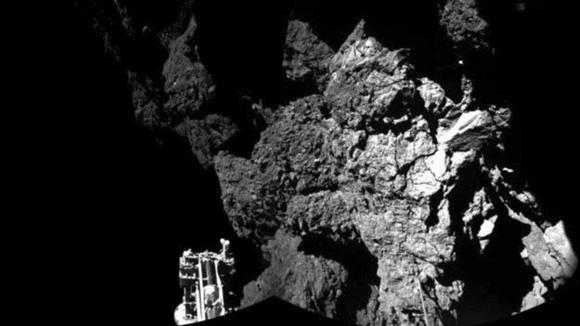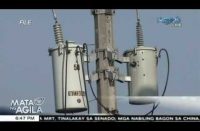
CREDIT: REUTERS/ESA/ROSETTA/PHILAE/CIVA/HANDOUT VIA REUTERS
(Reuters) – European Space Agency scientists faced an anxious wait on Friday to see if a probe landed on a comet has enough power left to send results of a drill down into its surface back to Earth 500 million km (300 million miles) away.
Time was getting tight after the probe, released by the Rosetta spacecraft on Wednesday after a 10-year odyssey from Earth, floated away from its planned landing site.
The washing machine-sized craft is now resting in the shadow of a cliff on the celestial body and appears to be surrounded by rocks, preventing sunlight from reaching the solar panels that should power it once its primary batteries run down on Friday.
One of the most important tasks for the 100-kg (220-pound) probe – dubbed Philae and weighing only 1 gram on the comet’s low gravity surface – was to drill into rock to analyze samples.
Comets are of interest to scientists because they constitute remnants from the formation of our solar system more than 4.6 billion years ago. These masses of ice and rock have preserved ancient organic molecules like a time capsule and may provide insight into how planets and life evolved.
Philae’s drill descended more than 25 centimeters (10 inches) on Friday but ESA said it was unclear whether it had penetrated the comet’s surface.
The radio link between Rosetta and Philae has been interrupted as the spacecraft orbits. The next time the mothership will get to contact Philae for developments will be around 1600 ET.
“This will be exciting because we’re not sure if the batteries will have enough power to transmit this data,” said Stefan Ulamec, Philae lander manager at the German Aerospace Center (DLR).
Compounding problems caused by the lack of light reaching its solar panels, an ESA command for Philae to enter low power mode to maximize battery life did not get through.
The ESA team are looking at options to move the probe into a position where it could draw more light, such as using a flywheel to “hop” the craft out of the enclosure of rocks.
Another solution could be rotating its solar panels, which would not require moving Philae out of its current location.
But they will undertake such measures only if there proves to be enough battery power to transmit the drilling results.
The mission has achieved many breakthroughs, including the first time a spacecraft has followed a comet rather than just whizzing past and the first time a probe has landed on a comet.
If Philae’s mission comes to an end on Friday, the Rosetta spacecraft will follow the comet until at least the end of 2015, even as it passes closest to the sun on its orbit.
“This mission is fantastic, let’s look at what we have achieved, not at what we would have done differently. This is unique and will be unique forever,” said Andrea Accomazzo, the Rosetta flight director.






